 W
WThe silky anteater, also known as the pygmy anteater, has traditionally been considered a single species of anteater, Cyclopes didactylus, in the genus Cyclopes, the only living genus in the family Cyclopedidae. Found in southern Mexico, and Central and South America, it is the smallest of all known anteaters. It has nocturnal habits and appears to be completely arboreal; its hind feet are highly modified for climbing.
 W
WThe nine-banded armadillo, or the nine-banded, long-nosed armadillo, is a medium-sized mammal found in North, Central, and South America, making it the most widespread of the armadillos. Its ancestors originated in South America, and remained there until the formation of the Isthmus of Panama allowed them to enter North America as part of the Great American Interchange. The nine-banded armadillo is a solitary, mainly nocturnal animal, found in many kinds of habitats, from mature and secondary rainforests to grassland and dry scrub. It is an insectivore, feeding chiefly on ants, termites, and other small invertebrates. The armadillo can jump 3–4 ft (91–122 cm) straight in the air if sufficiently frightened, making it a particular danger on roads. It is the state small mammal of Texas.
 W
WThe Bahamian raccoon, also called Bahama raccoon or Bahamas raccoon, is a subspecies of the common raccoon endemic on the New Providence Island in the Bahamas. The binomial name, maynardi, comes from Charles Johnson Maynard, an American naturalist.
 W
WThe bare-tailed woolly opossum is an opossum from South America. It was first described by Swedish zoologist Carl Linnaeus in 1758. The bare-tailed woolly opossum is characterized by a gray head, brown to gray coat, orange to gray underside and a partially naked tail. It is nocturnal and solitary; there is hardly any social interaction except between mother and juveniles and in mating pairs. The opossum constructs nests in tree cavities, and its litter size ranges from one to seven. Gestation lasts 25 days, and the juveniles exit the pouch after three months; weaning occurs a month later. The bare-tailed woolly opossum inhabits subtropical forests, rainforests, secondary forests, and plantations; its range extends from northern Venezuela to northeastern and southcentral Brazil. The IUCN classifies this opossum as least concern.
 W
WThe Brazilian porcupine is a porcupine found in Brazil, Argentina, Colombia, Venezuela, Guyana, French Guiana, Peru, Paraguay, Suriname, Bolivia and Trinidad, with a single record from Ecuador. It inhabits tropical forests at elevations up to 1500 m.
 W
WThe Brown weeper capuchin or Venezuelan brown capuchin is a species of gracile capuchin monkey from Venezuela.
 W
WThe tufted capuchin, also known as brown capuchin, black-capped capuchin, or pin monkey is a New World primate from South America. As traditionally defined, it is one of the most widespread primates in the Neotropics, but it has recently been recommended considering the black-striped, black and golden-bellied capuchins as separate species in a new genus, thereby effectively limiting the tufted capuchin to the Amazon basin and nearby regions.
 W
WWhite-fronted capuchin can refer to any of a number of species of gracile capuchin monkey which used to be considered as the single species Cebus albifrons. White-fronted capuchins are found in seven different countries in South America: Bolivia, Brazil, Colombia, Venezuela, Ecuador, Peru, and Trinidad and Tobago.
 W
WThe capybara is a giant cavy rodent native to South America. It is the largest living rodent in the world. Also called capivara, chigüire, chigüiro, or fercho, carpincho and ronsoco, it is a member of the genus Hydrochoerus, of which the only other extant member is the lesser capybara. Its close relatives include guinea pigs and rock cavies, and it is more distantly related to the agouti, the chinchilla, and the coypu. The capybara inhabits savannas and dense forests and lives near bodies of water. It is a highly social species and can be found in groups as large as 100 individuals, but usually lives in groups of 10–20 individuals. The capybara is not a threatened species, but it is hunted for its meat and hide and also for grease from its thick fatty skin.
 W
WThe Caribbean monk seal, West Indian seal or sea wolf was a species of seal native to the Caribbean, and is now believed to be extinct. The Caribbean monk seals' main predators were sharks and humans. Overhunting of the seals for oil, and overfishing of their food sources, are the established reasons for the seals' extinction. The last confirmed sighting of the Caribbean monk seal was in 1952 at Serranilla Bank, between Jamaica and Nicaragua. In 2008, the species was officially declared extinct by the United States, after an exhaustive search for the seals that lasted for about five years. This analysis was conducted by the National Oceanic and Atmospheric Administration and the National Marine Fisheries Service. Caribbean monk seals were closely related to Hawaiian monk seals, which live around the Hawaiian Islands and are now endangered, and Mediterranean monk seals, another endangered species.
 W
WThe Central American agouti is a species of agouti from the family Dasyproctidae. The main portion of its range is from Chiapas and the Yucatan Peninsula, through Central America, to northwestern Ecuador, Colombia and far western Venezuela. A highly disjunct population is found in southeastern Peru, far southwestern Brazil, Bolivia, western Paraguay and far northwestern Argentina. The disjunct population has been treated as a separate species, the brown agouti, but a major review of the geographic variation is necessary. The Central American agouti has also been introduced to Cuba and the Cayman Islands.
 W
WThe common opossum, also called the southern or black-eared opossum or gambá, and sometimes called a possum, is a marsupial species living from the northeast of Mexico to Bolivia, including Trinidad and Tobago, where it is called manicou. It prefers the woods, but can also live in fields and cities.
 W
WThe common vampire bat is a small, leaf-nosed bat native to Latin America. It is one of three extant species of vampire bat, the other two being the hairy-legged and the white-winged vampire bats. The common vampire bat practices hematophagy, mainly feeding on the blood of livestock. The bat usually approaches its prey at night while they are sleeping. It then uses its razor-sharp teeth to cut open the skin of its hosts and lap up their blood with its long tongue.
 W
WThe Jamaican coney, also known as the Jamaican hutia and the Browns hutia, is a hutia found in the rocky, forested areas of Jamaica, and is endemic to the island. It is in the order Rodentia and the family Capromyidae.
 W
WThe Cozumel raccoon, also called the pygmy raccoon, is a critically endangered species of island raccoon endemic on Cozumel Island off the coast of the Yucatan Peninsula, Mexico.
 W
WThe crab-eating raccoon or South American raccoon is a species of raccoon native to marshy and jungle areas of Central and South America. It is found from Costa Rica south through most areas of South America east of the Andes down to northern Argentina and Uruguay. Despite its name, this species is not restricted to eating only crabs, and the common raccoon also seeks and eats crabs where they are available.
 W
WThe Cuban solenodon or almiqui, is a species of eulipotyphlan endemic to Cuba. It belongs to the family Solenodontidae along with a similar species, the Hispaniolan solenodon. The solenodon is unusual among mammals in that its saliva is venomous.
 W
WThe dusky slender opossum is a species of opossum in the family Didelphidae. It is found in Colombia, Trinidad and Tobago, and Venezuela. It is threatened by habitat loss.
 W
WThe Caribbean region is home to two unique families of the mammalian order Eulipotyphla, which also includes the hedgehogs, gymnures shrews, moles and desmans. Only one Caribbean family, that of the solenodons, is still extant; the other, Nesophontidae, became extinct within the last few centuries.
 W
WThe European hare, also known as the brown hare, is a species of hare native to Europe and parts of Asia. It is among the largest hare species and is adapted to temperate, open country. Hares are herbivorous and feed mainly on grasses and herbs, supplementing these with twigs, buds, bark and field crops, particularly in winter. Their natural predators include large birds of prey, canids and felids. They rely on high-speed endurance running to escape predation, having long, powerful limbs and large nostrils.
 W
WThe Guadeloupe raccoon is a common raccoon endemic on the two main islands Basse-Terre Island and Grande-Terre of Guadeloupe in the Lesser Antilles.
 W
WThe Guiana dolphin, also known as the estuarine dolphin or costero, is a dolphin found in the coastal waters to the north and east of South America, and east of Central America. It is a member of the oceanic dolphin family (Delphinidae). It can live in both saltwater and freshwater.
 W
WThe Hispaniolan hutia is one of several hutia species to have inhabited at some time the island of Hispaniola. P. aedium is the only scientifically confirmed extant species of the genus Plagiodontia, and the only extant species of hutia on Hispaniola; other species are either extinct or being debatedly catalogued as P. aedium subspecies. The name Plagiodontia means "oblique tooth" in Greek.
 W
WThe Guyanan red howler is a species of howler monkey, a type of New World monkey, native to Suriname, Guyana, Trinidad, French Guiana, Venezuela and Brazil.
 W
WThe humpback whale is a species of baleen whale. It is one of the larger rorqual species, with adults ranging in length from 12–16 m (39–52 ft) and weighing around 25–30 metric tons. The humpback has a distinctive body shape, with long pectoral fins and a knobbly head. It is known for breaching and other distinctive surface behaviors, making it popular with whale watchers. Males produce a complex song lasting 10 to 20 minutes, which they repeat for hours at a time. All the males in a group will produce the same song, which is different each season. Its purpose is not clear, though it may help induce estrus in females.
 W
WThe Bahamian hutia or Ingraham's hutia is a species of rodent in the family Capromyidae. Geocapromys ingrahami is endemic to the Bahamas. Its natural habitats are subtropical or tropical moist lowland forest, subtropical or tropical dry shrubland, and rocky areas.
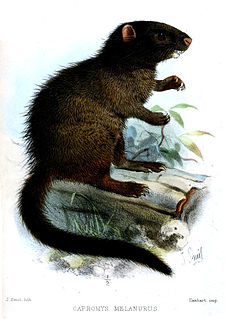 W
WThe black-tailed hutia or bushy-tailed hutia is a species of rodent in the family Capromyidae that is endemic to lowland moist forests on the island of Cuba. It is threatened by habitat loss.
 W
WCabrera's hutia is a species of rodent in the family Capromyidae. It is endemic to Cuba. Its natural habitats are subtropical or tropical mangrove forests and swamps. It is threatened by habitat loss.
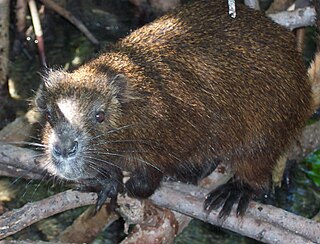 W
WThe Desmarest's hutia, also known as the Cuban hutia, is a species of rodent endemic to Cuba, although an extinct subspecies is known from the Cayman Islands. Weighing up to 8.5 kg (19 lb), it is the largest of the extant species of hutia.
 W
WThe Javan mongoose or small Indian mongoose is a mongoose species native to South and Southeast Asia that has also been introduced to many regions of the world.
 W
WThe Caribbean region is home to a diverse and largely endemic rodent fauna. This includes the endemic family Capromyidae (hutias), which are largely limited to the Greater Antilles, and two other groups of endemic hystricognaths, the heteropsomyines and giant hutias, including the extinct bear-sized Amblyrhiza inundata. Lesser Antillean rodent faunas mostly consist of oryzomyines, members of a distantly related group of rodents, and include two of the largest known oryzomyines, Megalomys desmarestii and "Oryzomys hypenemus". Various other rodents are limited to land-bridge islands such as Trinidad, which were connected to the mainland during glacial-period lowered sea levels in the Pleistocene, or to smaller portions of the Caribbean archipelago. Much of the native rodent fauna of the Caribbean are extinct because of human influences, particularly following the introduction of invasive species such as Old World rats.
 W
WThe lowland paca, also known as the spotted paca, is a large rodent found in tropical and sub-tropical America, from east-central Mexico to northern Argentina, and has been introduced to Cuba and Algeria.
 W
WThe West Indian manatee or "sea cow", also known as North American manatee, is the largest surviving member of the aquatic mammal order Sirenia. It is further divided into two subspecies, the Florida manatee and the Antillean or Caribbean manatee, based on genetic and morphological studies. The Florida subspecies is primarily found along the coasts of Florida, but its range extends as far west as Texas and as far north as Massachusetts. The Antillean subspecies has a sparse distribution throughout the Caribbean, ranging as far north as Mexico and as far south as Brazil.
 W
WThe ground sloths of the extinct genus Megalocnus were among the largest of the Caribbean ground sloths, with individuals estimated to have weighed up to 90 kg (200 lb) when alive. Two species have been described, M. rodens of Cuba, and M. zile of Hispaniola. Their relatives include other Caribbean ground sloths, such as Acratocnus, Mesocnus, Miocnus, Neocnus, Parocnus, and Paulocnus. M. zile is currently thought to be a junior synonym of Parocnus serus.
 W
WThe Mexican agouti is a species of rodent in the family Dasyproctidae. It is native to Mexico, and has been introduced to Cuba. It is rated Critically Endangered on the IUCN's red list.
 W
WThe green monkey, also known as the sabaeus monkey or the callithrix monkey, is an Old World monkey with golden-green fur and pale hands and feet. The tip of the tail is golden yellow as are the backs of the thighs and cheek whiskers. It does not have a distinguishing band of fur on the brow, like other Chlorocebus species, and males have a pale blue scrotum. Some authorities consider this and all of the members of the genus Chlorocebus to be a single widespread species, Chlorocebus aethiops.
 W
WThe mona monkey is an Old World monkey that lives in western Africa between Ghana and Cameroon. The mona monkey can also be found on the island of Grenada as it was transported to the island aboard slave ships headed to the New World during the 18th century. This guenon lives in groups of up to thirty-five in forests. It mainly feeds on fruit, but sometimes eats insects and leaves. The mona monkey has brown agouti fur with a white rump. Its tail and legs are black and the face is blue-grey with a dark stripe across the face. The mona monkey carries food in cheek pouches.
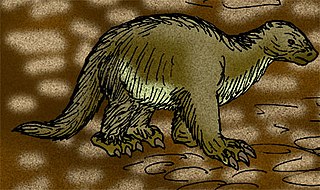 W
WNeocnus is an extinct genus of ground sloth, whose species ranged across Cuba and Hispaniola. Neocnus would have resembled a typical ground sloth, though much smaller, with a longer tail and a broad trunk, as well as lissome limbs and long claws. This sloth was known for having caudal vertebrae that were broad, a trait shared with other ground sloths, indicating that this animal, like the tamandua of today, likely used its tail to stand upright. The caniniform teeth of the Neocnus were large and triangular, and its skull was deep and had a large, sagittal crest which, when used with the deep mandible likely allowed strong exertion by the masticatory muscles.
 W
WThe ocelot is a wild cat native to the southwestern United States, Mexico, and Central and South America, as well as the Caribbean islands of Trinidad and Margarita. This medium-sized cat is characterized by solid black spots and streaks on its coat, round ears, and white neck and undersides. It weighs between 8 and 15.5 kg and reaches 40–50 cm at the shoulders. It was first described by Carl Linnaeus in 1758. Two subspecies are recognized: L. p. pardalis and L. p. mitis.
 W
WOecomys trinitatis, also known as the long-furred oecomys, long-furred rice rat, Trinidad arboreal rice rat, or big arboreal rice rat, is a species of rodent in the genus Oecomys of family Cricetidae. As currently constituted, it has a wide distribution in Central America and South America, being found in southern Costa Rica, Panama, Colombia, Venezuela, Trinidad and Tobago, Guyana, Suriname, French Guiana, much of Brazil, eastern Ecuador, and eastern Peru. It may in fact include more than one species.
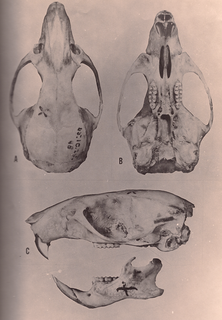 W
WOryzomys antillarum, also known as the Jamaican rice rat, is an extinct rodent of Jamaica. A member of the genus Oryzomys within the family Cricetidae, it is similar to O. couesi of mainland Central America, from where it may have dispersed to its island during the last glacial period. O. antillarum is common in subfossil cave faunas and is also known from three specimens collected live in the 19th century. Some historical records of Jamaican rats may pertain to it. The species probably became extinct late in the 19th century, perhaps due to the introduction of the small Asian mongoose, competition with introduced rodents such as the brown rat, and habitat destruction.
 W
WThe neotropical otter or neotropical river otter is an otter species found in Central America, South America and the island of Trinidad. It is physically similar to the northern and southern river otter, which occur directly north and south of this species' range. The length of the neotropical otter can range from 36–66 centimetres (14–26 in), plus a tail of 37–84 centimetres (15–33 in). Body weight ranges from 5–15 kilograms (11–33 lb). Otters are members of the family Mustelidae, the most species-rich family in the order Carnivora.
 W
WThe collared peccary is a species of mammal in the family Tayassuidae found in North, Central, and South America. They are commonly referred to as javelina, saíno, or báquiro, although these terms are also used to describe other species in the family. The species is also known as the musk hog. In Trinidad, it is colloquially known as quenk.
 W
WThe prehensile-tailed hutia is a species of rodent in the family Capromyidae endemic to Cuba. It is an arboreal foliovore, found in both primary and secondary forest. Its karyotype has 2n = 34 and FN = 54-56.
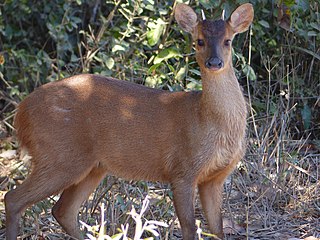 W
WThe red brocket is a species of brocket deer from forests in South America, ranging from northern Argentina to Colombia and the Guianas. It also occurs on the island of Trinidad in the Republic of Trinidad and Tobago.
 W
WThe red-rumped agouti, also known as the golden-rumped agouti, orange-rumped agouti or Brazilian agouti, is a species of agouti from the family Dasyproctidae. It is native to northeastern South America, where found in Venezuela, Guyana, Suriname, French Guiana, northeastern Brazil, and Trinidad and Tobago. It has also been introduced to the U.S. Virgin Islands, Grenada, and Dominica. Despite the alternative name Brazilian agouti, it is neither the only nor the most widespread species of agouti in Brazil. In Brazil all agoutis are often called "cutia" [kuˈtʃiɐ].
 W
WThe red-tailed squirrel is a largish tree squirrel distributed from southern Central to northern South America.
 W
WThe Ruatan Island agouti, also called the Roatán Island agouti, is a species of agouti in the family Dasyproctidae. It is endemic to the island of Roatán, off the north coast of Honduras, and is threatened by habitat loss and hunting. There are no known subspecies.
 W
WThe San Felipe hutia, also known as the little earth hutia, formerly found in Cuba, is listed on the 2008 IUCN Red List as Critically Endangered, possibly extinct.
 W
WThe Hispaniolan solenodon, also known as the Haitian solenodon, or agouta, is a solenodon found only on Hispaniola, the island shared by Haiti and the Dominican Republic. It was first described by Brandt in 1833. A similar but smaller species, Marcano's solenodon, once lived on the island, but became extinct after European colonization.
 W
WThe southern tamandua, also called the collared anteater or lesser anteater, is a species of anteater from South America. It is a solitary animal, found in many habitats from mature to highly disturbed secondary forests and arid savannas. It feeds on ants, termites, and bees. Its very strong fore claws can be used to break insect nests or to defend itself.
 W
WThe tayra is an omnivorous animal from the weasel family, native to the Americas. It is the only species in the genus Eira.
 W
WThe Trinidad spiny pocket mouse is a species of rodent in the family Heteromyidae. It is found in Colombia, Trinidad and Tobago, and Venezuela.
 W
WThe Trinidad spiny rat is a species of rodent in the family Echimyidae. It is found in Trinidad and Tobago and northern Venezuela.
 W
WThe western Cuban nesophontes is an extinct species of mammal in the family Nesophontidae. It was found in Cuba and Hispaniola.
 W
WThe white-tailed deer, also known as the whitetail or Virginia deer, is a medium-sized deer native to North America, Central America, Ecuador, and South America as far south as Peru and Bolivia. It has also been introduced to New Zealand, all the Greater Antilles in the Caribbean, and some countries in Europe, such as the Czech Republic, Finland, Romania, Serbia, Germany, and France. In the Americas, it is the most widely distributed wild ungulate.